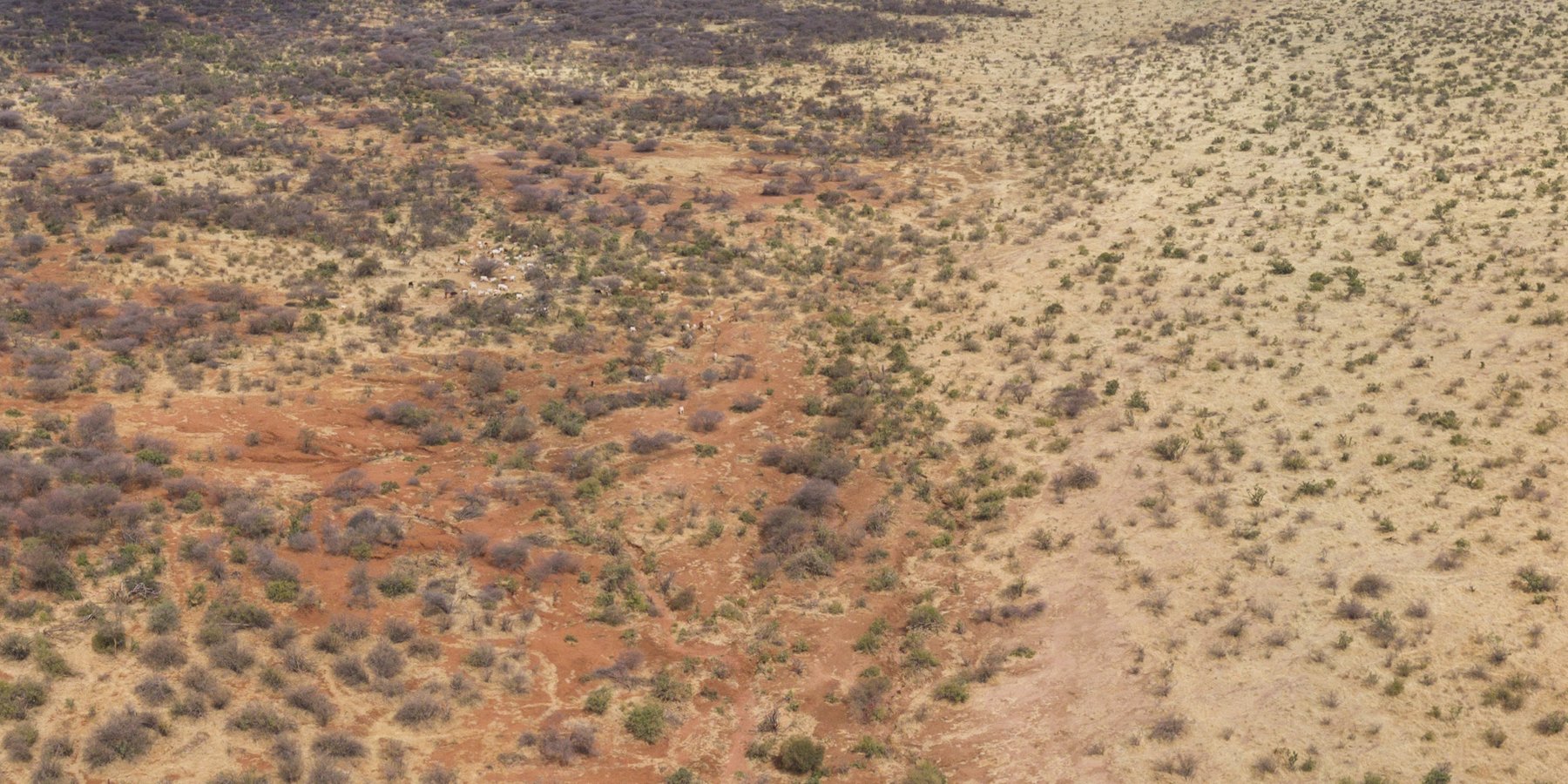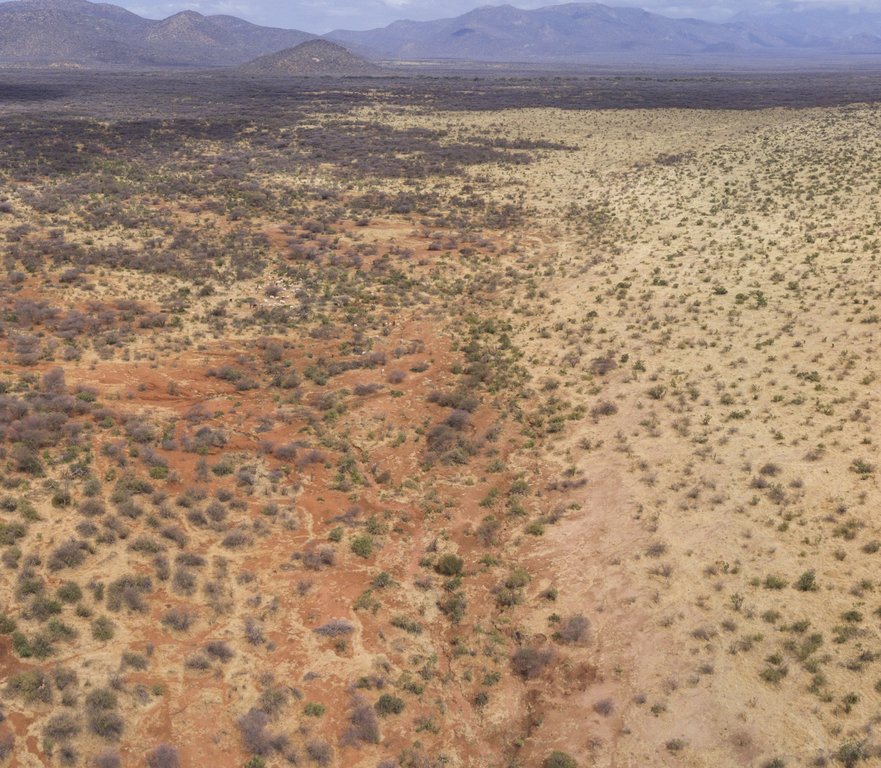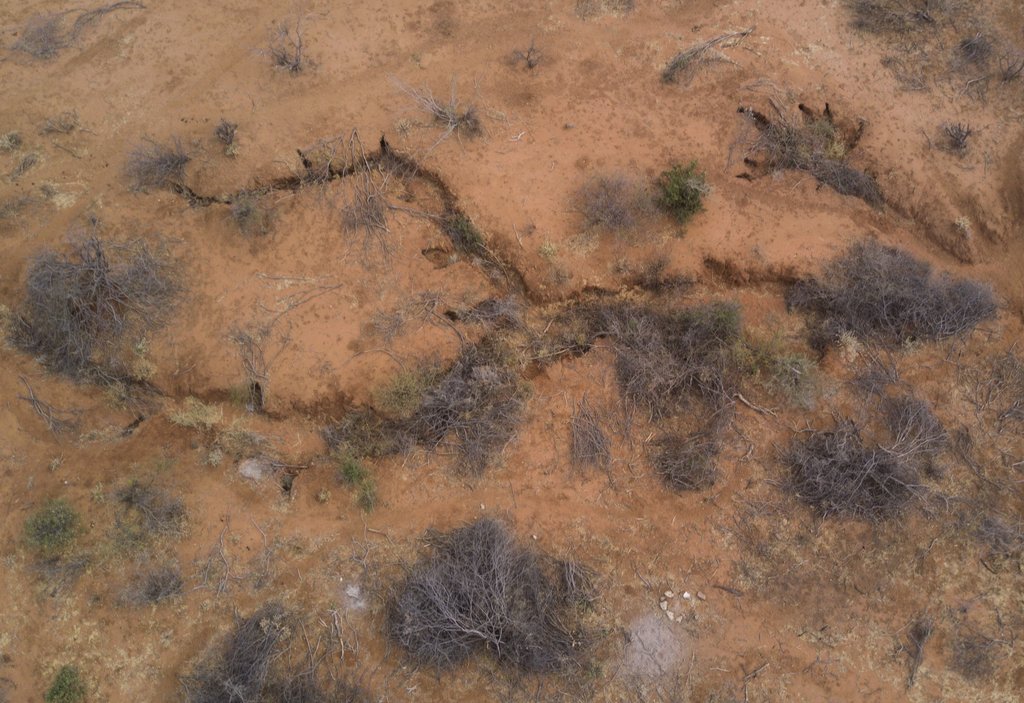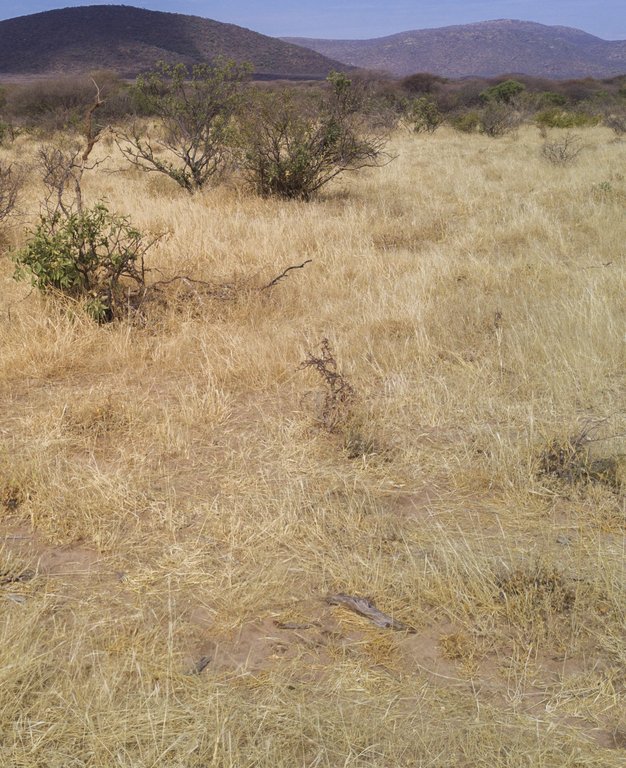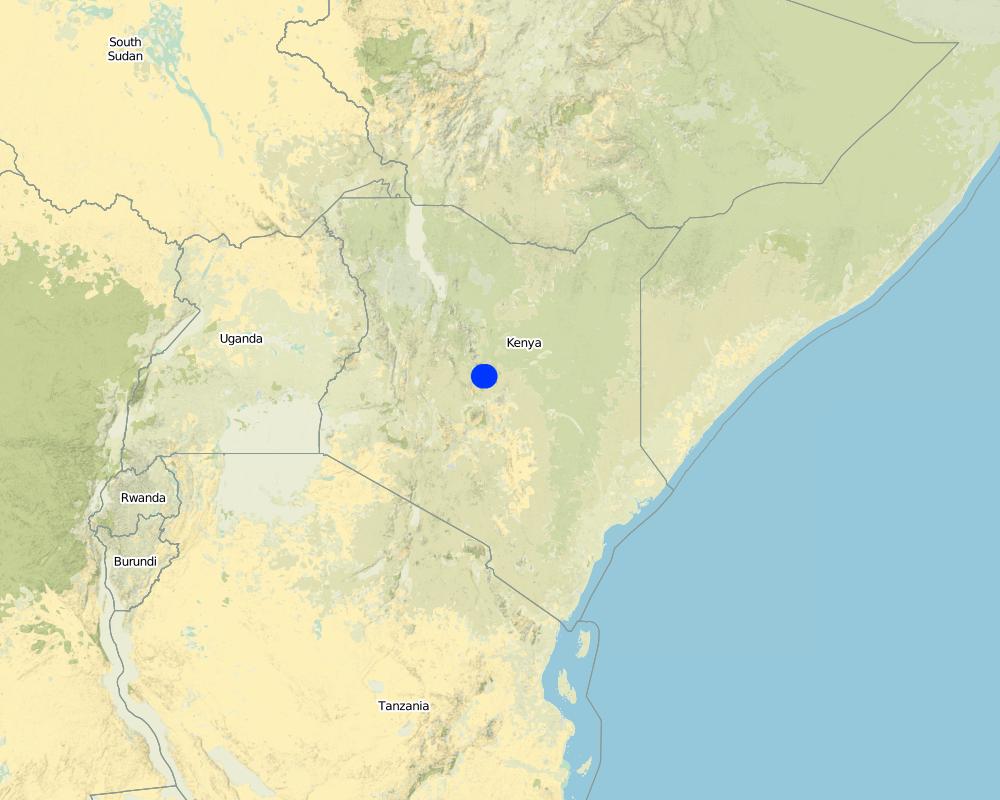Rangeland Restoration by cutting invasive species and grass reseeding and managing grazing [Kenya]
- Création :
- Mise à jour :
- Compilateur : Harry Wells
- Rédacteur : –
- Examinateur : Rima Mekdaschi Studer
technologies_3381 - Kenya
- Résumé complet en PDF
- Résumé complet en PDF pour impression
- Résumé complet dans le navigateur
- Résumé complet (non formaté)
- Restauration des parcours, par la coupe des espèces envahissantes, le réensemencement et la gestion des pâturages: 16 juillet 2018 (inactive)
- Restauration des parcours, par la coupe des espèces envahissantes, le réensemencement et la gestion des pâturages: 6 mai 2019 (inactive)
- Restauration des parcours, par la coupe des espèces envahissantes, le réensemencement et la gestion des pâturages: 3 septembre 2018 (inactive)
- Restauration des parcours, par la coupe des espèces envahissantes, le réensemencement et la gestion des pâturages: 2 novembre 2021 (public)
- Rangeland Restoration by cutting invasive species and grass reseeding and managing grazing : 23 mars 2018 (inactive)
Voir les sections
Développer tout Réduire tout1. Informations générales
1.2 Coordonnées des personnes-ressources et des institutions impliquées dans l'évaluation et la documentation de la Technologie
Personne(s)-ressource(s) clé(s)
exploitant des terres:
1.3 Conditions relatives à l'utilisation par WOCAT des données documentées
Quand les données ont-elles été compilées (sur le terrain)?
26/01/2018
Le compilateur et la(les) personne(s) ressource(s) acceptent les conditions relatives à l'utilisation par WOCAT des données documentées:
Oui
1.4 Déclaration sur la durabilité de la Technologie décrite
Est-ce que la Technologie décrite ici pose problème par rapport à la dégradation des terres, de telle sorte qu'elle ne peut pas être déclarée comme étant une technologie de gestion durable des terres?
Non
1.5 Référence au(x) questionnaire(s) sur les Approches de GDT
2. Description de la Technologie de GDT
2.1 Courte description de la Technologie
Définition de la Technologie:
This 'Rangeland Restoration' technology is part of a 'Holistic Rangeland Management' approach. It involves clearing of invasive vegetation (predominantly Acacia reficiens) and reseeding with grass (Cenchrus ciliaris) and allowing resting and reduced grazing pressure to rehabilitate degraded communal grazing land.
2.2 Description détaillée de la Technologie
Description:
The 'Rangeland Restoration' technology is applied in degraded sites within the 3,100 Ha 'core conservation area' (an central area with minimised grazing pressure designated for tourism) and 'buffer zone' (an area surrounding the 'core conservation area' with reduced grazing pressure) of the Kalama Community Wildlife Conservancy (total area: 9,500 Ha).
The main characteristics are clearing of invasive woody vegetation (predominantly Acacia reficiens) and reseeding with grass (Cenchrus ciliaris). Acacia reficiens (commonly known as red-bark acacia, red thorn or false umbrella tree or thorn) is a native tree or shrub but is considered an invasive species as it can encroach degraded areas with bare and disturbed soil. It is very opportunistic and hardy and can subsequently take over large areas of native vegetation. The invasion can reach a closed or nearly closed canopy with A. reficiens thickets, which are hindering animals to enter and access fodder thus making the area inaccessible for grazing and browsing. Additionally it can be observed that the soil underneath the canopy remains bare and the grass growth seems to be suppressed. As a result the top soil is compacted or forms crusts, which hinder infiltration. During the erratic but heavy rains most of the water flows away as runoff (research in close by areas show that runoff is between 60-80 % of the rainfall) and increases soil erosion and further degradation of the land despite a rather good tree cover. Rangeland grass and fodder productivity in these areas are reduced to a fraction of their potential.
The main activity is the cutting of the trees and shrubs at a height of ~1 m. The main trunks and branches can be used for fencing, temporary house constructions, firewood and charcoal. Most of the cut trees and the remaining branches are used to spread on the bare land where the trees and shrubs are cut. Underneath this dead material the bare soil receives some cover, which creates favorable conditions and microclimate for termites and other fauna in the soil to brake the hard top soil and crust and enable infiltration of the water during the next rains. This allows regrowth of grasses, particularly in the areas protected by the branches. In the following seasons the spread of the grasses can increase also the the area not protected by the branches. Additionally, seeding with Cenchrus ciliaris (buffel-grass or African foxtail grass), a grass species which is native to most of Africa, enhances the growth of a highly valuable fodder grass. Seeds are hand-broadcasted in the treated areas and germinate during the next rainy season. The first greening is visible in the places where the branches and the wood pieces cover the soil. From there the local annual and perennial grasses start colonising and expanding in the following seasons until, ideally, the whole area that has been bare is covered by valuable perennial grasses. Parallel to the cutting and reseeding is reduced grazing pressure and a resting period over at least one dry season, which is facilitated by the fact that treated areas are situated in the core conservation area or in the buffer zone. This involves the cooperation of the members of Kalama Conservancy, who agree to restrict grazing in the buffer zone and more so in the core conservation area. The exact duration that grazing is allowed in each of these two areas varies year to year depending on drought severity and forage availability. Whereas the grazing pressure by livestock can be regulated, there remains uncontrolled grazing by wildlife. The major herbivores are zebra, elephants and a number of different gazelle and antelope species the grazing pressure by wildlife varies but can be substantial at certain times.
Rehabilitating degraded grazing land is the primary purpose of the technology. Other benefits of the technology include: 1) augmented forage availability for the community; 2) increased livestock production; 3) reduced soil erosion and flooding. Land users enjoy these benefits but would like larger areas to be similarly restored. However, the limiting factor is the funding required to pay for labour, which is the major input required for the clearing and reseeding activities. Establishing a market for removing the main stems and producing and selling charcoal is still an opportunity to further explore immediate benefits and cash income in order to pay for the investment into the clearing.
2.3 Photos de la Technologie
2.5 Pays/ région/ lieux où la Technologie a été appliquée et qui sont couverts par cette évaluation
Pays:
Kenya
Région/ Etat/ Province:
Samburu County
Map
×2.6 Date de mise en œuvre de la Technologie
Indiquez l'année de mise en œuvre:
2006
Si l'année précise est inconnue, indiquez la date approximative: :
- il y a entre 10-50 ans
2.7 Introduction de la Technologie
Spécifiez comment la Technologie a été introduite: :
- par le biais de projets/ d'interventions extérieures
Commentaires (type de projet, etc.) :
Acacia reficiens was already selectively cleared traditionally when constructing livestock corrals ('bomas'), but the introduction of more extensive clearing and grass-reseeding to rehabilitate specific areas was facilitated by Northern Rangeland Trust and Grevy's Zebra Trust.
3. Classification de la Technologie de GDT
3.1 Principal(aux) objectif(s) de la Technologie
- réduire, prévenir, restaurer les terres dégradées
- préserver l'écosystème
- conserver/ améliorer la biodiversité
3.2 Type(s) actuel(s) d'utilisation des terres, là où la Technologie est appliquée

Pâturages
Pâturage extensif:
- Semi-nomadisme/ pastoralisme
- Ranching
Principales espèces animales et principaux produits:
Cattle (milk, beef), Sheep/Goats (milk, meat), Camels (milk, meat), Donkeys

Terres improductives
Précisez:
Bare and/or degraded land
Remarques:
The area has been overused and continuously grazed for a long period of time without given the land and vegetation a break to recover. Thus a vicious spiral developed: the reduced grass cover lead to degradation of the soil to compaction and crusting, reduced infiltration thus reduced runoff and reduced vegetation growth, which in turn increased the pressure on the remaining vegetation and thus more base soil etc.
3.3 Informations complémentaires sur l'utilisation des terres
Approvisionnement en eau des terres sur lesquelles est appliquée la Technologie:
- pluvial
Nombre de période de croissance par an: :
- 2
Précisez:
Rainiy seasons from April to June and from October to December but with high variability in time and amount
Densité d'élevage/ chargement (si pertinent):
likely continuously growing till technology was introduced
3.4 Groupe de GDT auquel appartient la Technologie
- pastoralisme et gestion des pâturages
- Amélioration de la couverture végétale/ du sol
- amélioration des variétés végétales, des races animales
3.5 Diffusion de la Technologie
Spécifiez la diffusion de la Technologie:
- appliquée en des points spécifiques ou concentrée sur une petite surface
3.6 Mesures de GDT constituant la Technologie

pratiques végétales
- V2: Herbes et plantes herbacées pérennes
- V4: Remplacement ou suppression des espèces étrangères envahissantes

modes de gestion
- M2: Changement du niveau de gestion / d'intensification
3.7 Principaux types de dégradation des terres traités par la Technologie

érosion hydrique des sols
- Wt: perte de la couche superficielle des sols (couche arable)/ érosion de surface
- Wg: ravinement/ érosion en ravines

dégradation physique des sols
- Pc: compaction
- Pk: scellage et encroûtement

dégradation biologique
- Bc: réduction de la couverture végétale
- Bs: baisse de la qualité et de la composition/ diversité des espèces
- Bl: perte de la vie des sols

dégradation hydrique
- Ha: aridification
3.8 Prévention, réduction de la dégradation ou réhabilitation des terres dégradées
Spécifiez l'objectif de la Technologie au regard de la dégradation des terres:
- réduire la dégradation des terres
- restaurer/ réhabiliter des terres sévèrement dégradées
4. Spécifications techniques, activités, intrants et coûts de mise en œuvre
4.1 Dessin technique de la Technologie
4.2 Spécification/ explications techniques du dessin technique
A total of 279 hectares were treated with this rangeland restoration technology (clearing invasive Acacia reficiens and reseeding with Cenchrus ciliaris). Treated areas were relatively flat (slope < 5%). A. reficiens were cut ~1 m above the ground and well before the onset of the rains to discourage regeneration. C. ciliaris seeds were hand-broadcast at a rate of ~45 kg/Ha.
Holding membership of multiple community conservancies facilitates the movement between wet season and dry season grazing areas. For example, many of the local communities move their livestock to Losesia, in Sera Conservancy, for dry season grazing. These porous boundaries relieve pressure from Kalama Conservancy during some parts of the year, potentially facilitating recovery of treated areas, but also allows neighbouring communities to access treated areas rendering their grazing management challenging.
4.3 Informations générales sur le calcul des intrants et des coûts
Spécifiez la manière dont les coûts et les intrants ont été calculés:
- par superficie de la Technologie
Indiquez la taille et l'unité de surface:
279 hectares (total over 6 sites)
autre/ monnaie nationale (précisez):
Kenya Shillings
Indiquer le taux de change du dollars en monnaie locale (si pertinent): 1 USD= :
101,0
Indiquez le coût salarial moyen de la main d'œuvre par jour:
450 Kenya Shillings
4.4 Activités de mise en place/ d'établissement
| Activité | Type de mesures | Calendrier | |
|---|---|---|---|
| 1. | Clearing Acacia reficiens (cutting and spreading) | Végétale | During dry season, well before the onset of rains to prevent Acacia reficiens regrowth from stump. |
| 2. | Reseeding with Cenchrus ciliaris grass seed | Végétale | Prior to the onset of rainy season to maximise germination and establishment of Cenhrus ciliaris.. |
4.5 Coûts et intrants nécessaires à la mise en place
| Spécifiez les intrants | Unité | Quantité | Coûts par unité | Coût total par intrant | % des coût supporté par les exploitants des terres | |
|---|---|---|---|---|---|---|
| Main d'œuvre | Clearing Acacia reficiens | person-days | 1200,0 | 450,0 | 540000,0 | |
| Main d'œuvre | Hand-broadcasting Cenchrus ciliaris seeds | person-days | 1200,0 | 450,0 | 540000,0 | |
| Equipements | Machettes | units | 40,0 | 500,0 | 20000,0 | |
| Matériel végétal | Cenchrus ciliaris seeds | kg | 2520,0 | 50,0 | 126000,0 | |
| Autre | Transport of workers to and from site | litre | 600,0 | 100,0 | 60000,0 | |
| Coût total de mise en place de la Technologie | 1286000,0 | |||||
Si le coût n'est pas pris en charge à 100% par l'exploitant des terres, indiquez qui a financé le coût restant:
Funding raised by Northern Rangelands Trust and Grezy's Zebra Trust (including USAID and FAO funding).
Commentaires:
These are the costs associated a 55 Ha treated area. Six sites of a similar size were treated with similar budgets totalling 279 Ha.
4.6 Activités d'entretien/ récurrentes
Commentaires:
No maintenance activities.
4.7 Coûts et intrants nécessaires aux activités d'entretien/ récurrentes (par an)
Commentaires:
No maintenance costs.
4.8 Facteurs les plus importants affectant les coûts
Décrivez les facteurs les plus importants affectant les coûts :
Hiring labour, as it was the most costly component.
5. Environnement naturel et humain
5.1 Climat
Précipitations annuelles
- < 250 mm
- 251-500 mm
- 501-750 mm
- 751-1000 mm
- 1001-1500 mm
- 1501-2000 mm
- 2001-3000 mm
- 3001-4000 mm
- > 4000 mm
Spécifiez la pluviométrie moyenne annuelle (si connue), en mm:
351,00
Indiquez le nom de la station météorologique de référence considérée:
Archer's Post
Zone agro-climatique
- semi-aride
5.2 Topographie
Pentes moyennes:
- plat (0-2 %)
- faible (3-5%)
- modéré (6-10%)
- onduleux (11-15%)
- vallonné (16-30%)
- raide (31-60%)
- très raide (>60%)
Reliefs:
- plateaux/ plaines
- crêtes
- flancs/ pentes de montagne
- flancs/ pentes de colline
- piémonts/ glacis (bas de pente)
- fonds de vallée/bas-fonds
Zones altitudinales:
- 0-100 m
- 101-500 m
- 501-1000 m
- 1001-1500 m
- 1501-2000 m
- 2001-2500 m
- 2501-3000 m
- 3001-4000 m
- > 4000 m
Indiquez si la Technologie est spécifiquement appliquée dans des:
- non pertinent
5.3 Sols
Profondeur moyenne du sol:
- très superficiel (0-20 cm)
- superficiel (21-50 cm)
- modérément profond (51-80 cm)
- profond (81-120 cm)
- très profond (>120 cm)
Texture du sol (de la couche arable):
- grossier/ léger (sablonneux)
Texture du sol (> 20 cm sous la surface):
- grossier/ léger (sablonneux)
Matière organique de la couche arable:
- faible (<1%)
Si disponible, joignez une description complète du sol ou précisez les informations disponibles, par ex., type de sol, pH/ acidité du sol, capacité d'échange cationique, azote, salinité, etc.
pH ~7-8.5; SOC 4.7 g/kg of soil; Na ~0.1-0.4 cmolc/kg
5.4 Disponibilité et qualité de l'eau
Profondeur estimée de l’eau dans le sol:
> 50 m
Disponibilité de l’eau de surface:
faible/ absente
Qualité de l’eau (non traitée):
faiblement potable (traitement nécessaire)
La salinité de l'eau est-elle un problème? :
Non
La zone est-elle inondée?
Non
5.5 Biodiversité
Diversité des espèces:
- élevé
Diversité des habitats:
- moyenne
Commentaires et précisions supplémentaires sur la biodiversité:
Rangelands in Kenya are generally characterized by high bio-diversity. The particular sites have been degraded in terms of vegetation ans soils. After the restoration diversity increases but has not reached its full potential.
5.6 Caractéristiques des exploitants des terres appliquant la Technologie
Sédentaire ou nomade:
- Semi-nomade
Orientation du système de production:
- mixte (de subsistance/ commercial)
Revenus hors exploitation:
- > 50% de tous les revenus
Niveau relatif de richesse:
- moyen
Individus ou groupes:
- groupe/ communauté
Niveau de mécanisation:
- travail manuel
Genre:
- hommes
Age des exploitants des terres:
- jeunes
- personnes d'âge moyen
Indiquez toute autre caractéristique pertinente des exploitants des terres:
Kalama Conservancy receives considerable income from the high end tourism (~60% of total income) and donations (~25% of total income).
5.7 Superficie moyenne des terres détenues ou louées par les exploitants appliquant la Technologie
- < 0,5 ha
- 0,5-1 ha
- 1-2 ha
- 2-5 ha
- 5-15 ha
- 15-50 ha
- 50-100 ha
- 100-500 ha
- 500-1 000 ha
- 1 000-10 000 ha
- > 10 000 ha
Cette superficie est-elle considérée comme de petite, moyenne ou grande dimension (en se référant au contexte local)?
- grande dimension
Commentaires:
communally owned
5.8 Propriété foncière, droits d’utilisation des terres et de l'eau
Propriété foncière:
- communauté/ village
Droits d’utilisation des terres:
- communautaire (organisé)
Droits d’utilisation de l’eau:
- communautaire (organisé)
5.9 Accès aux services et aux infrastructures
santé:
- pauvre
- modéré
- bonne
éducation:
- pauvre
- modéré
- bonne
assistance technique:
- pauvre
- modéré
- bonne
emploi (par ex. hors exploitation):
- pauvre
- modéré
- bonne
marchés:
- pauvre
- modéré
- bonne
énergie:
- pauvre
- modéré
- bonne
routes et transports:
- pauvre
- modéré
- bonne
eau potable et assainissement:
- pauvre
- modéré
- bonne
services financiers:
- pauvre
- modéré
- bonne
6. Impacts et conclusions
6.1 Impacts sur site que la Technologie a montrés
Impacts socio-économiques
Production
production fourragère
Commentaires/ spécifiez:
due to degradation fodder production before was minimal both for grasses (hardly that survived the grazing pressure) as well as accessible browse material
qualité des fourrages
Commentaires/ spécifiez:
perennial grasses were brought back
production animale
production de bois
Commentaires/ spécifiez:
cut wood of the invasive species can be used for charcoal production, and construction material. The amount is high but the marketing is still weak, so most of it is left to be spread on the ground
qualité des forêts/ bois
Commentaires/ spécifiez:
one dominate invasive wood species was removed to give way for other native species to repopulate the area
Impacts socioculturels
sécurité alimentaire/ autosuffisance
connaissances sur la GDT/ dégradation des terres
apaisement des conflits
Impacts écologiques
Cycle de l'eau/ ruissellement
ruissellement de surface
Commentaires/ spécifiez:
There is still potential to decrease runoff further as the system is still recovering and improving.
Sols
humidité du sol
couverture du sol
perte en sol
encroûtement/ battance du sol
compaction du sol
cycle/ recharge des éléments nutritifs
matière organique du sol/ au dessous du sol C
Biodiversité: végétale, animale
Couverture végétale
biomasse/ au dessus du sol C
diversité végétale
6.2 Impacts hors site que la Technologie a montrés
inondations en aval
envasement en aval
dommages sur les infrastructures publiques/ privées
Commentaires/ spécifiez:
damage on major bridges but also on smaller within the conservancy
6.3 Exposition et sensibilité de la Technologie aux changements progressifs et aux évènements extrêmes/catastrophes liés au climat (telles que perçues par les exploitants des terres)
Changements climatiques progressifs
Changements climatiques progressifs
| Saison | Type de changements/ extrêmes climatiques | Comment la Technologie fait-elle face à cela? | |
|---|---|---|---|
| températures annuelles | augmente | modérément |
Extrêmes climatiques (catastrophes)
Catastrophes météorologiques
| Comment la Technologie fait-elle face à cela? | |
|---|---|
| pluie torrentielle locale | très bien |
Catastrophes climatiques
| Comment la Technologie fait-elle face à cela? | |
|---|---|
| sécheresse | bien |
6.4 Analyse coûts-bénéfices
Quels sont les bénéfices comparativement aux coûts de mise en place (du point de vue des exploitants des terres)?
Rentabilité à court terme:
positive
Rentabilité à long terme:
très positive
6.5 Adoption de la Technologie
- cas isolés/ expérimentaux
Parmi tous ceux qui ont adopté la Technologie, combien d'entre eux l'ont fait spontanément, à savoir sans recevoir aucune incitation matérielle ou aucun paiement?
- 0-10%
6.6 Adaptation
La Technologie a-t-elle été récemment modifiée pour s'adapter à l'évolution des conditions?
Non
6.7 Points forts/ avantages/ possibilités de la Technologie
| Points forts/ avantages/ possibilités du point de vue de l'exploitant des terres |
|---|
| Land that was previously considered unproductive is now considered grazing land. |
| Increased infiltration and decreased runoff and water erosion. |
| Recolonisation by local grasses and forbs to replace reseeded Cenchrus ciliaris after 1-2 years provides nutritious forage (particularly the forbs) for livestock. |
| Points forts/ avantages/ possibilités du point de vue du compilateur ou d'une autre personne ressource clé |
|---|
| Decreased impact of the invasive Acacia reficiens on vegetation and soil within treated areas. |
| Increased biomass of herbaceous vegetation for livestock and wildlife forage. |
| Augmented biodiversity after reseeded Cenchrus ciliaris replaced by local grasses and forbs. |
6.8 Faiblesses/ inconvénients/ risques de la Technologie et moyens de les surmonter
| Faiblesses/ inconvénients/ risques du point de vue de l’exploitant des terres | Comment peuvent-ils être surmontés? |
|---|---|
| Creates overly high expectations from the community regarding the potential to restore larger areas. | Raise awareness among community members regarding the limitations of large-scale restoration. |
| Lack of funds to pay labourers. Paying community members to undertake restoration activities rather than these activities being voluntary is now, in hindsight, perceived to have been a mistake. | There will never be enough funding as labourers will continue to expect ever-increasing wages. However, over time, community members may decide to restore land voluntarily. Explore the potential for marketing the main trunks for charcoal production of firewood to pay for the labourers. |
| Controlling grazing in recovering areas. | Raise awareness about the restoration projects within immediate and neighbouring communities. Also, ensure grazing by-laws are implemented and offenders fined. |
| Land users unwilling to voluntarily take part in restoration activities. | Increase ownership by conducting restoration projects at more local zonal-levels rather than at the conservancy-level. Create additional incentives by using and marketing of some of the wood material (for legal charcoal production) |
| Faiblesses/ inconvénients/ risques du point de vue du compilateur ou d'une autre personne ressource clé | Comment peuvent-ils être surmontés? |
|---|---|
| Inability to provide adequate rest to treated areas (i.e. by controlling grazing pressure) leading to unsuccessful establishment of Cenchrus ciliaris or other herbaceous vegetation in treated areas, particularly in 'buffer zone'. | Implement grazing rules more stringently. |
| Lack of capacity regarding how to reseed Cenchrus ciliaris in some treated areas. In one case, seeds were buried (as farmers do with maize seeds), which is reported to have contributed to low establishment success of C. ciliaris seeds. | Capacity building. |
| Germination and establishment of Cenchrus ciliaris depends on timing in relation to the onset of rains, which are unpredictable and led to unsuccessful rehabilitation of some treated areas. | Provide most accurate weather forecasts available. |
7. Références et liens
7.1 Méthodes/ sources d'information
- visites de terrain, enquêtes sur le terrain
2 field visits to the sites
- interviews/entretiens avec les exploitants des terres
3 informants
- compilation à partir de rapports et d'autres documents existants
1 report
7.2 Références des publications disponibles
Titre, auteur, année, ISBN:
'Northern Rangeland Trust: Baseline assessment of rangeland health - Kalama and Namunyak conservancies', Tor-G. Vågen & Leigh A. Winowiecki, 2014
Disponible à partir d'où? Coût?
https://cgspace.cgiar.org/bitstream/handle/10568/65671/nrtReport_march2014.pdf?sequence=1
7.3 Liens vers les informations pertinentes disponibles en ligne
Titre/ description:
Northern Rangeland Trust: Baseline assessment of rangeland health - Kalama and Namunyak conservancies
URL:
https://cgspace.cgiar.org/bitstream/handle/10568/65671/nrtReport_march2014.pdf?sequence=1
Liens et modules
Développer tout Réduire toutLiens
Aucun lien
Modules
Aucun module trouvé


